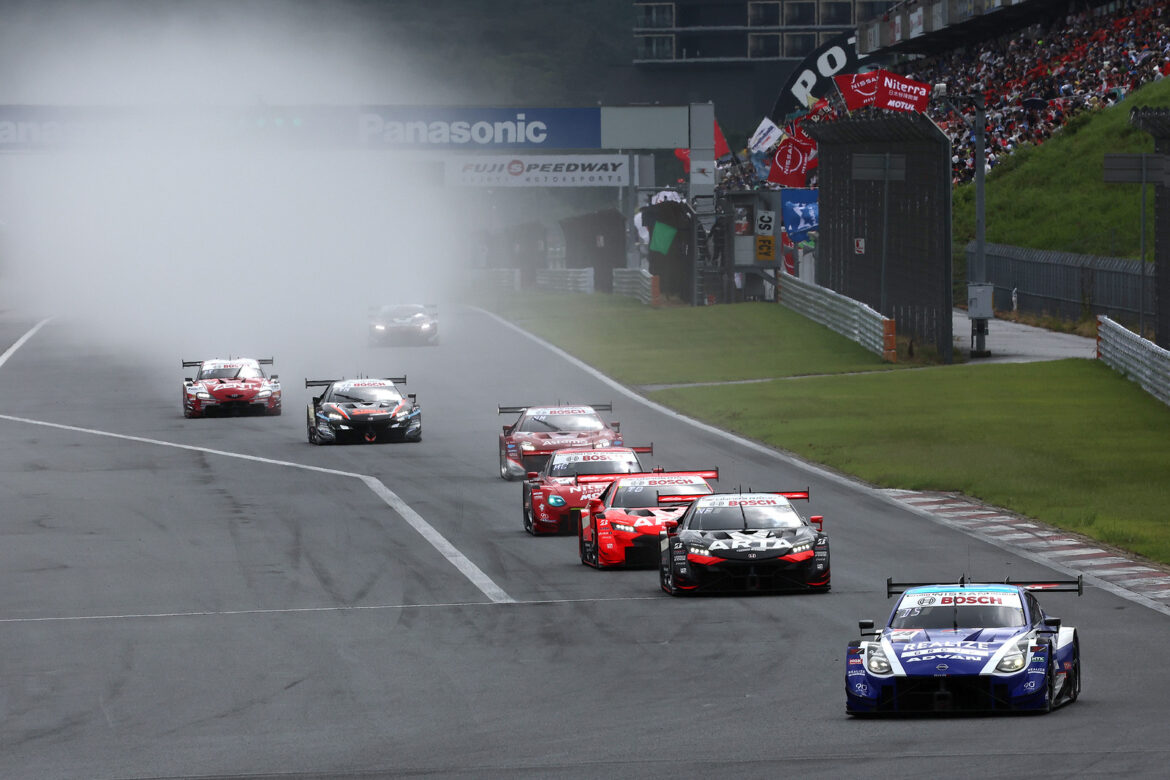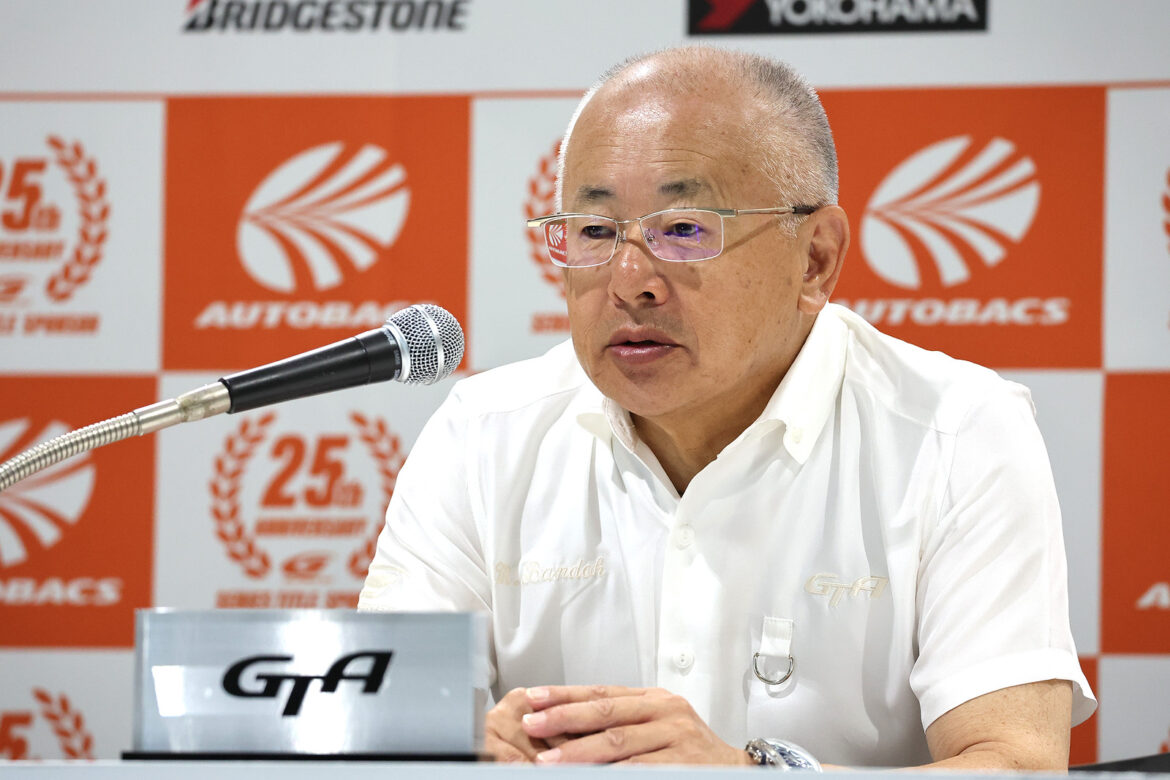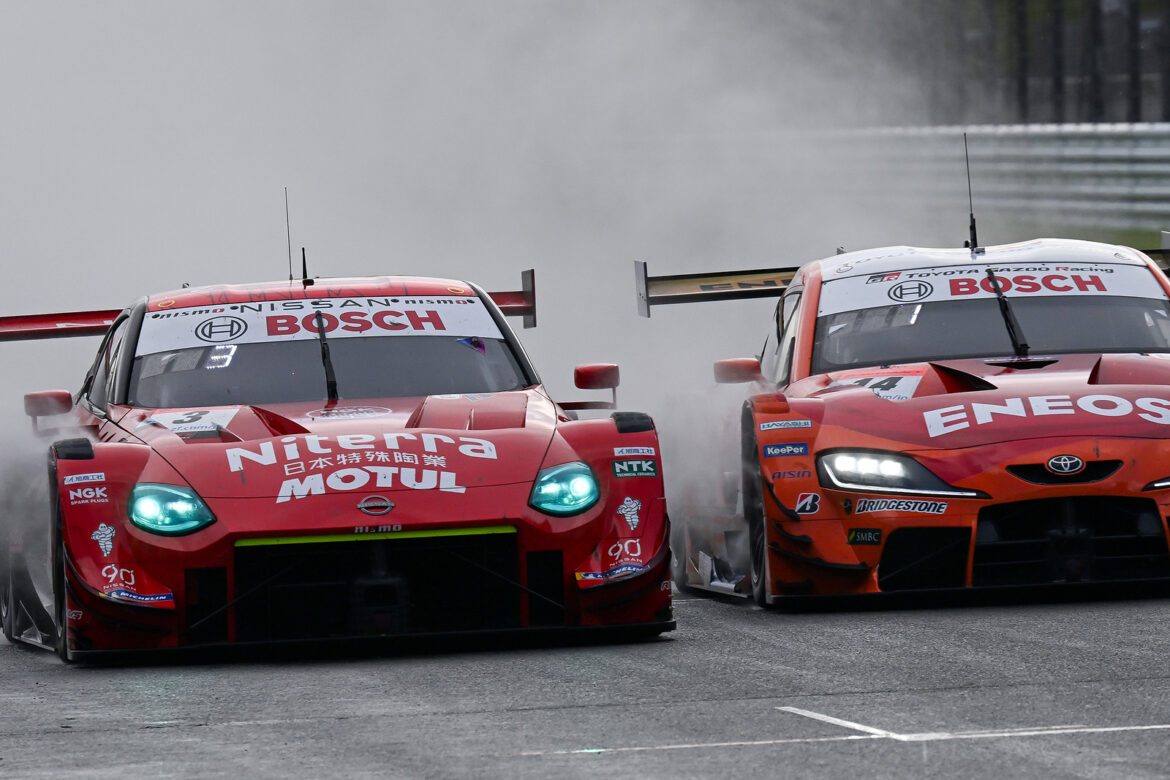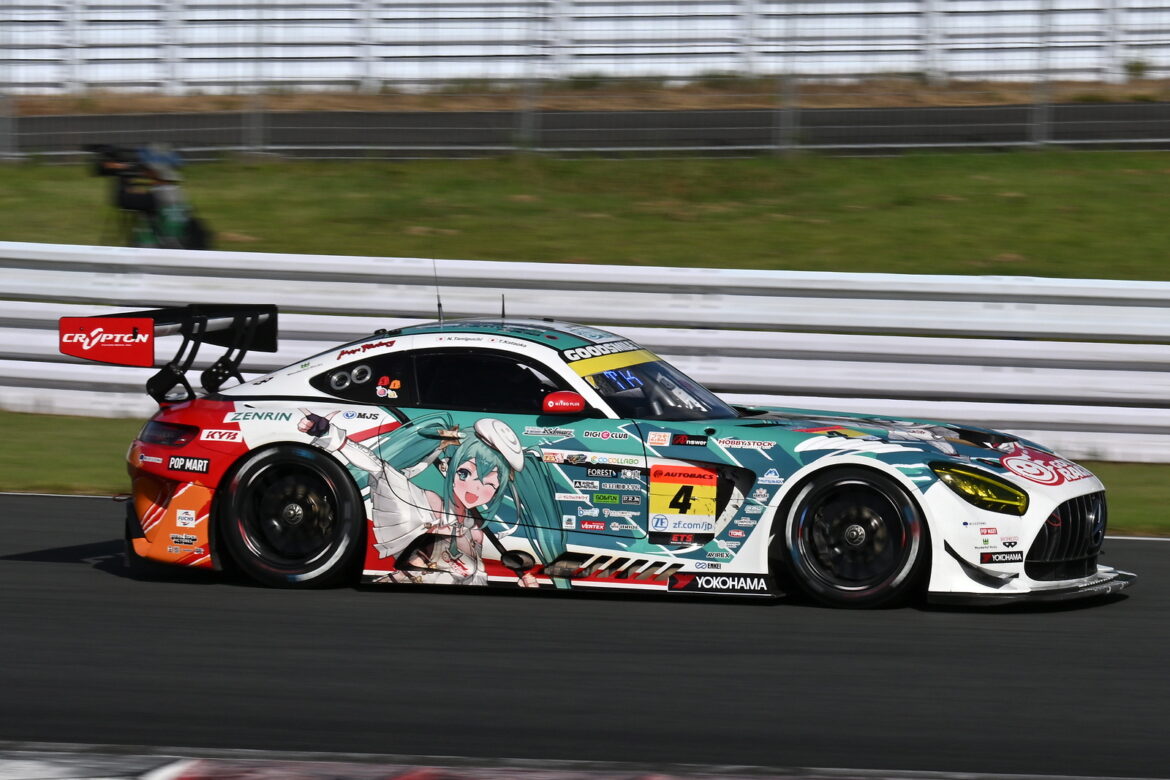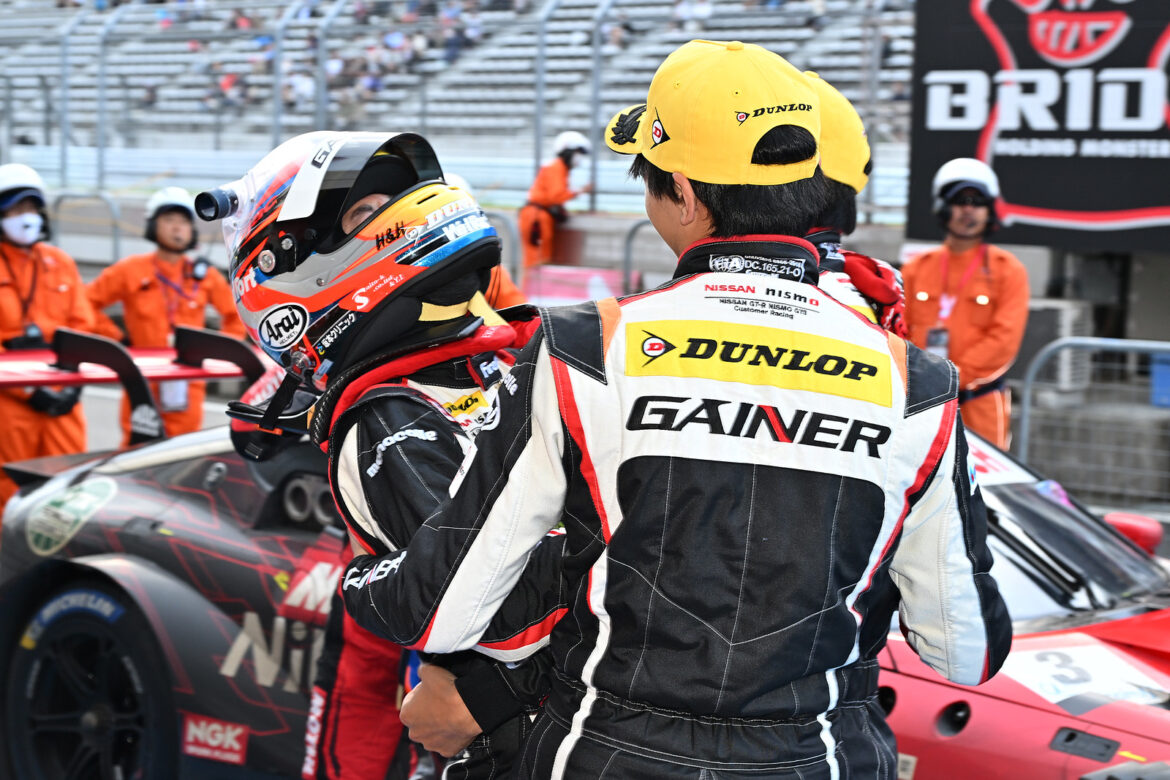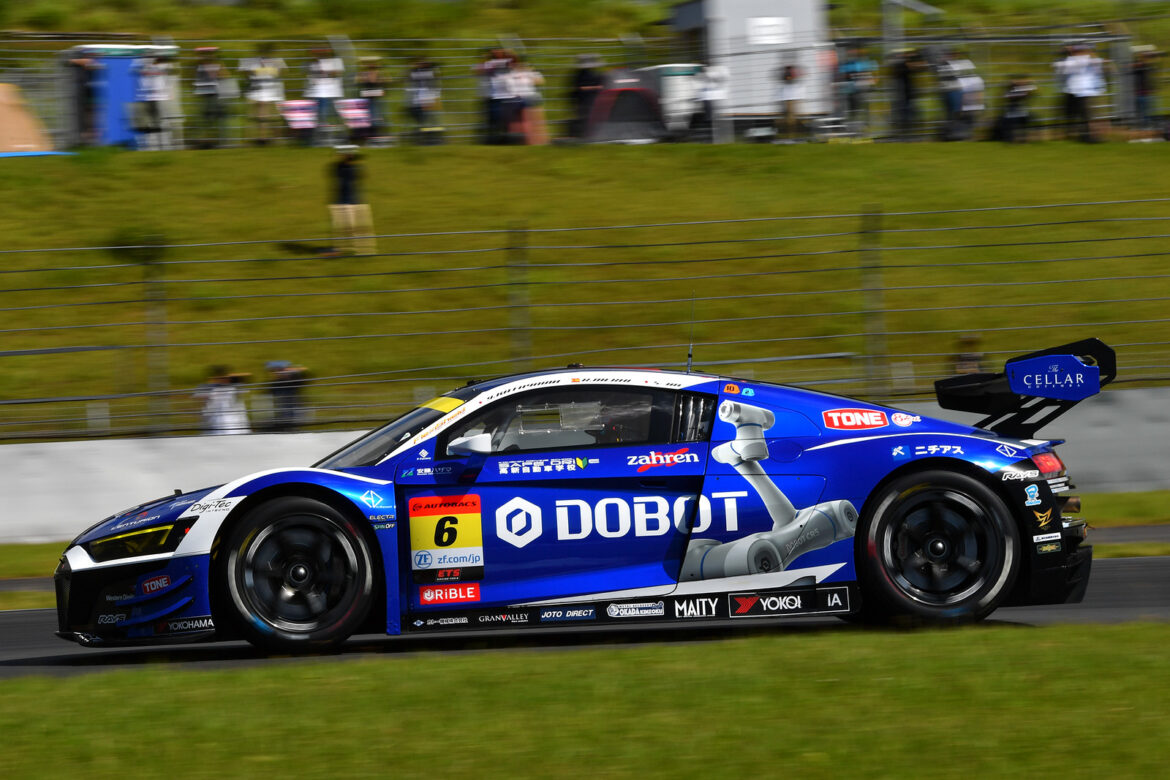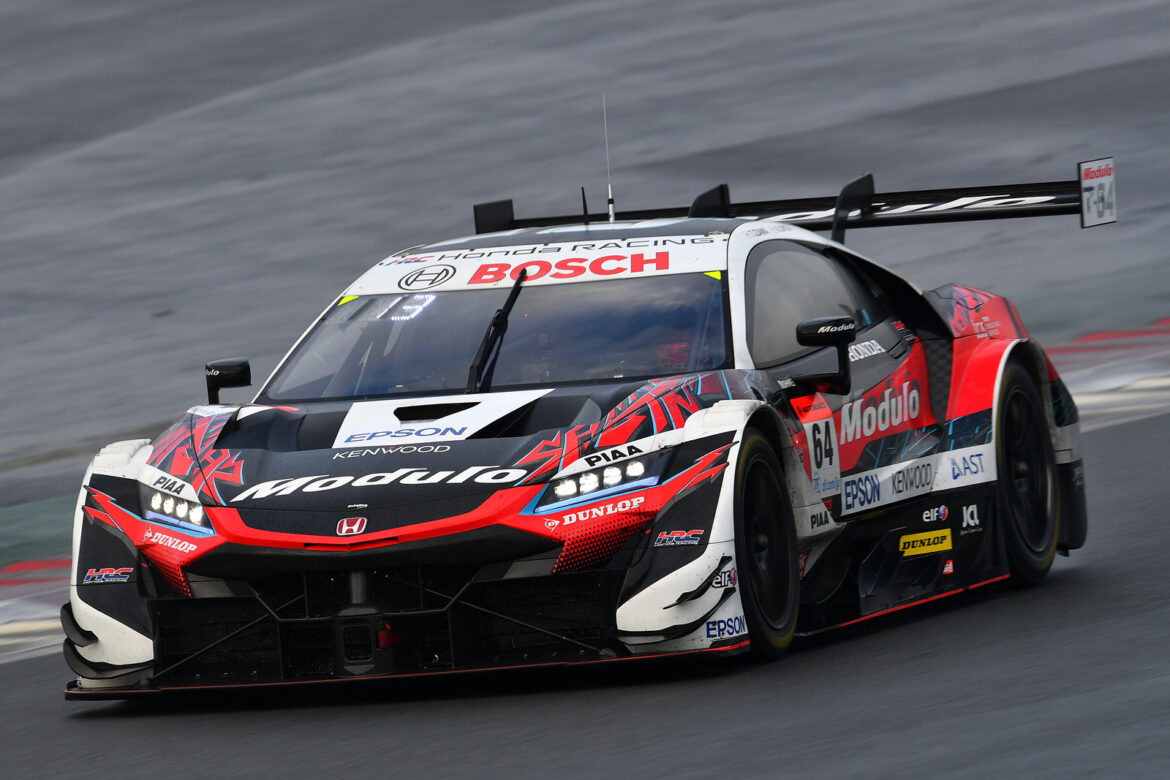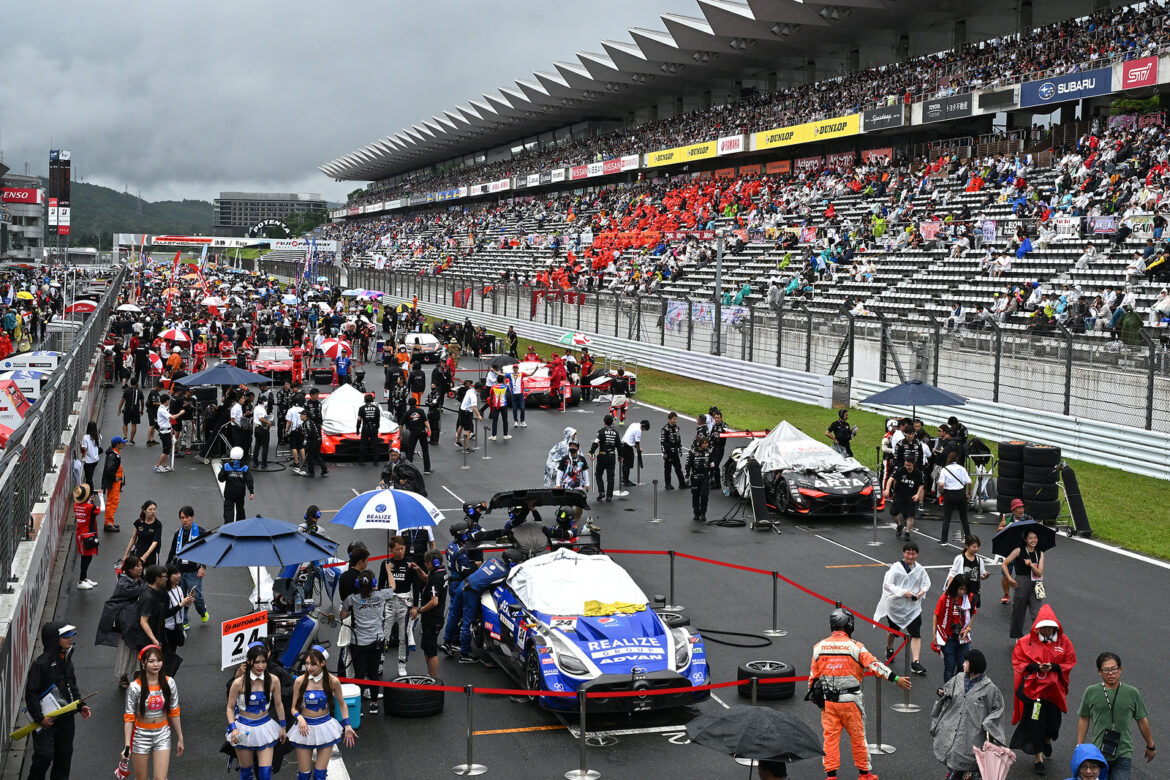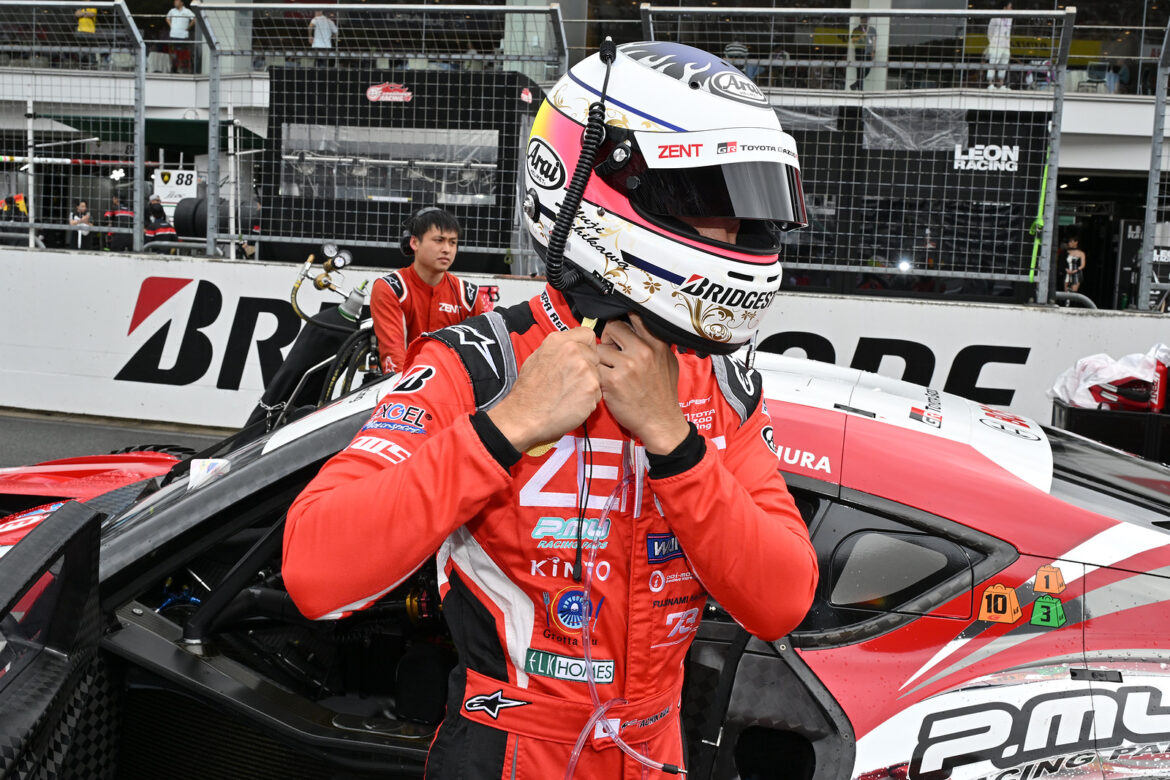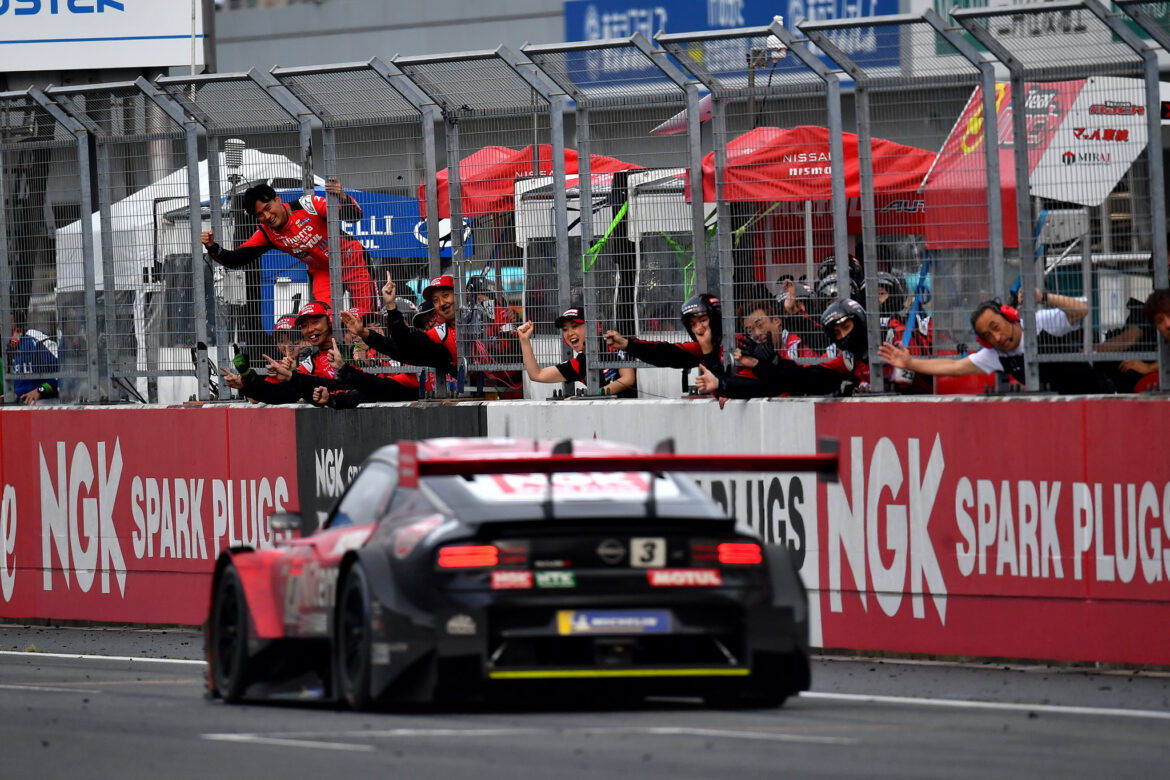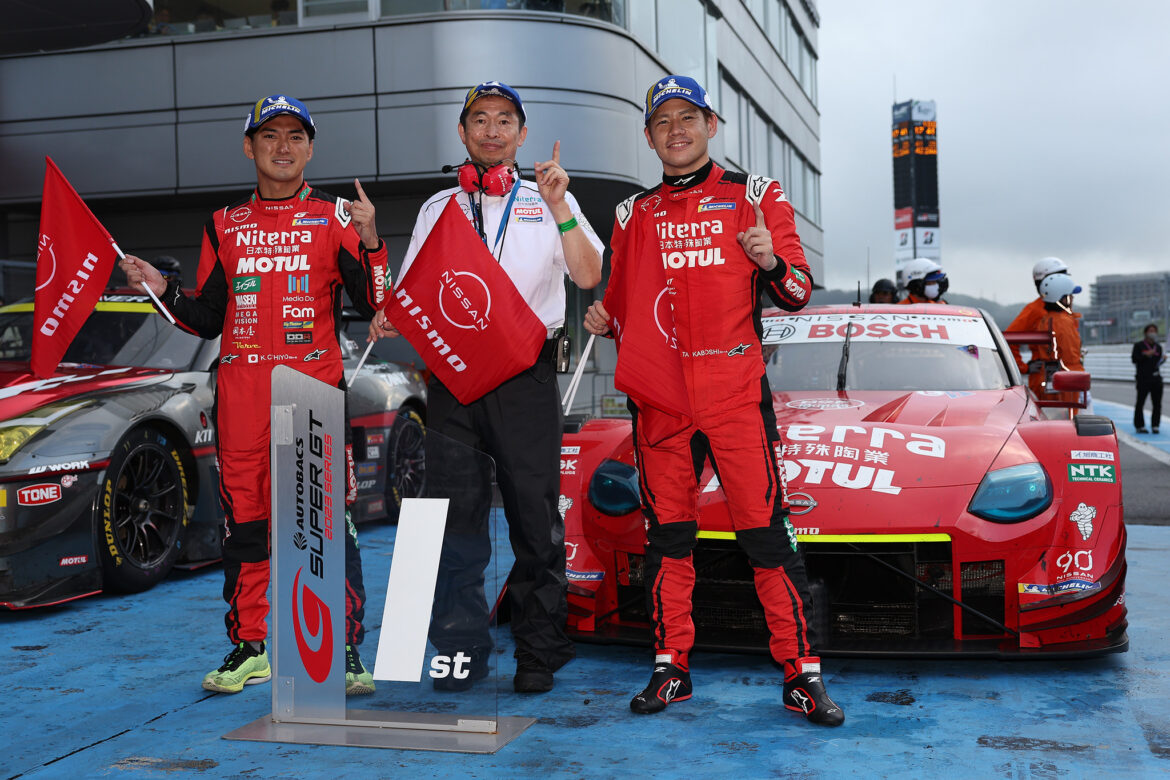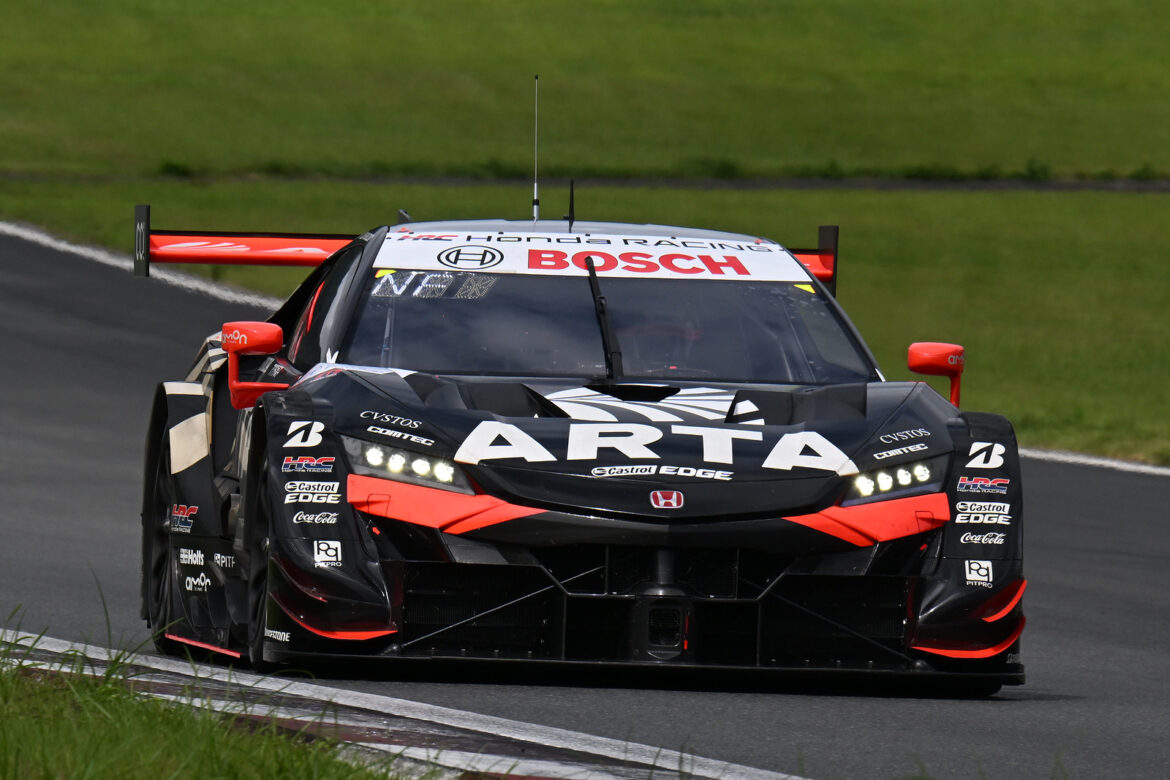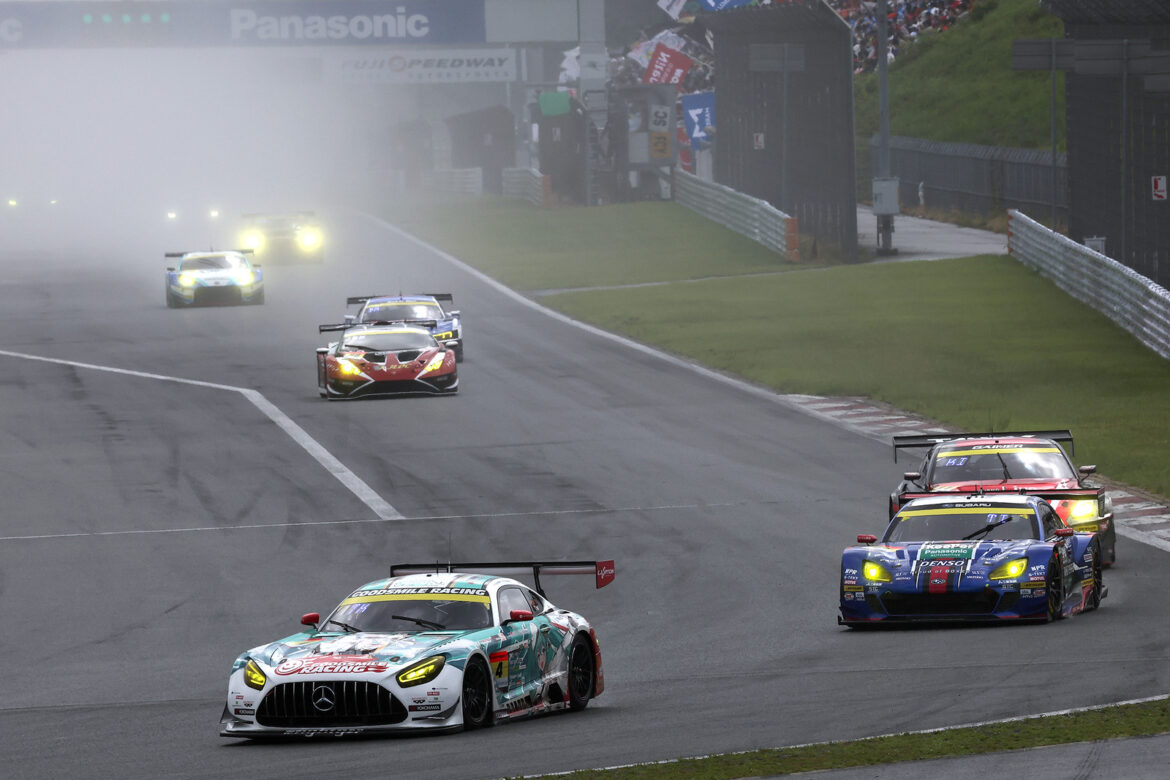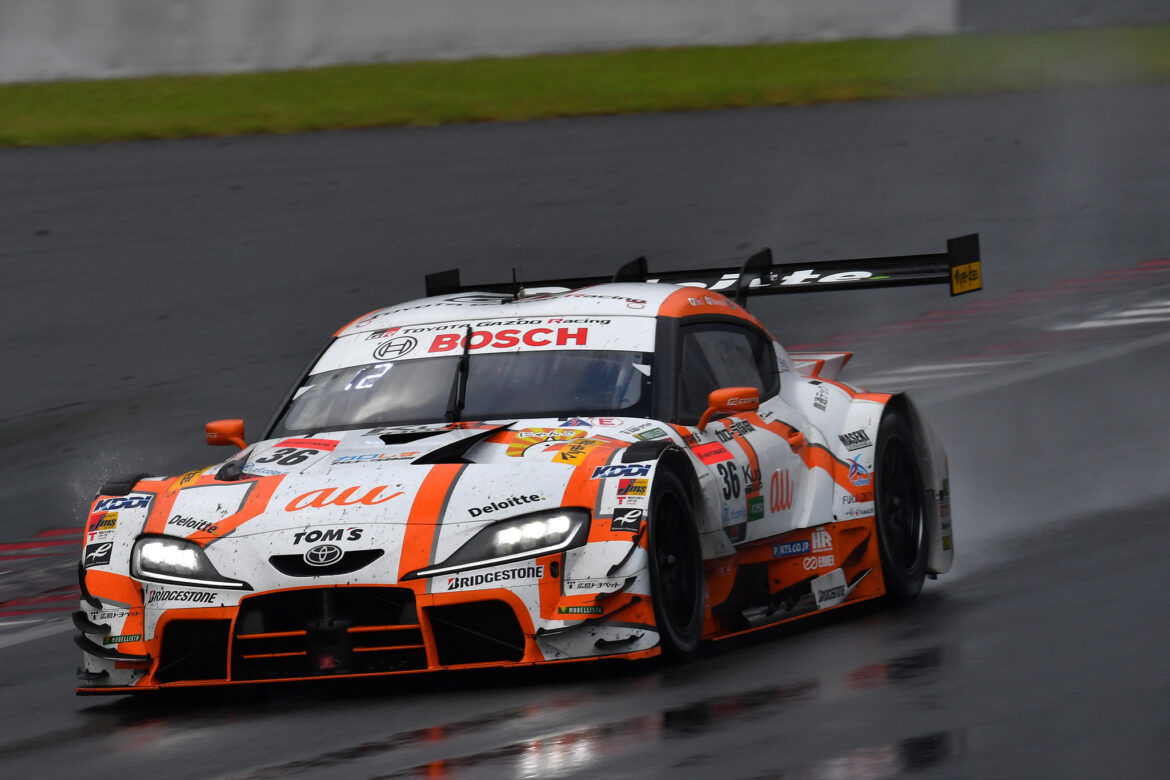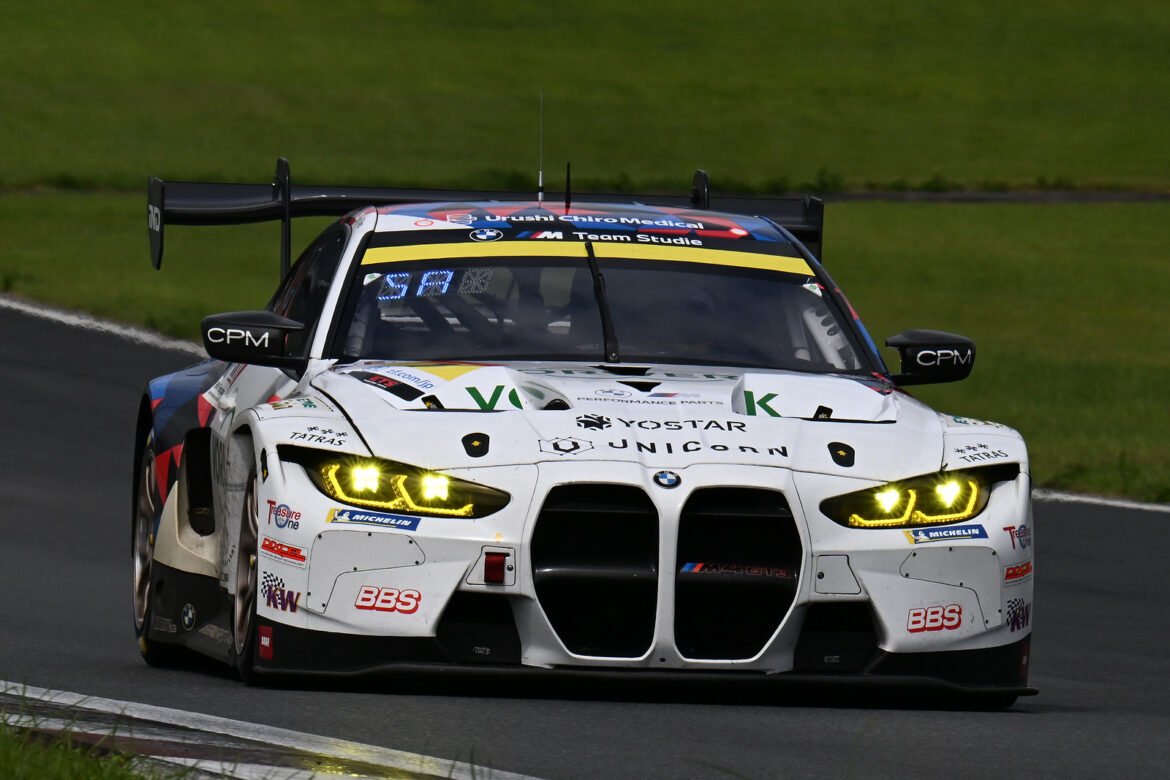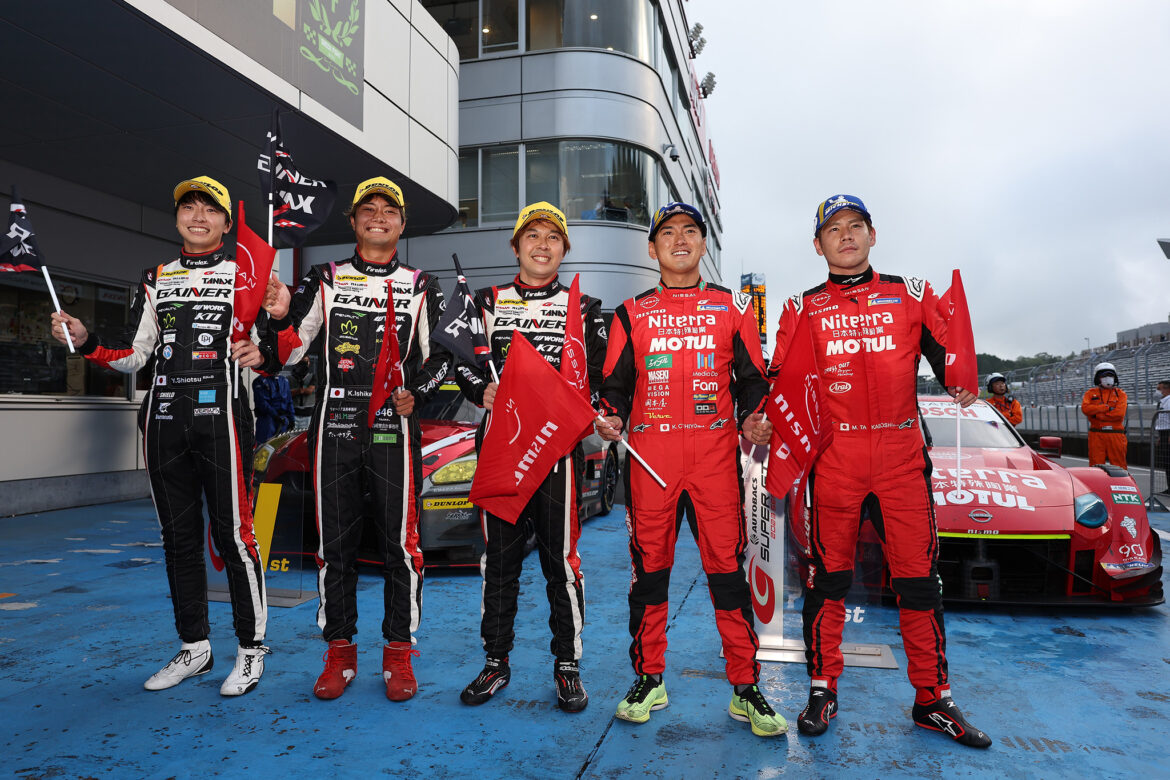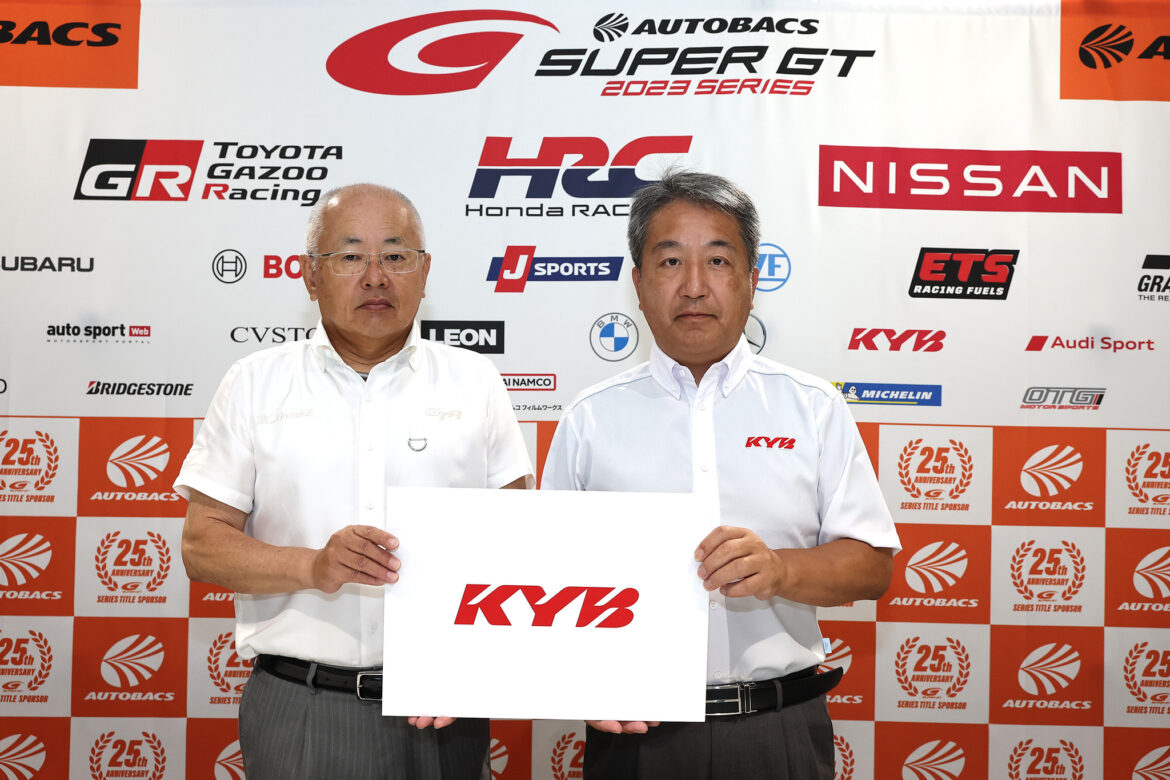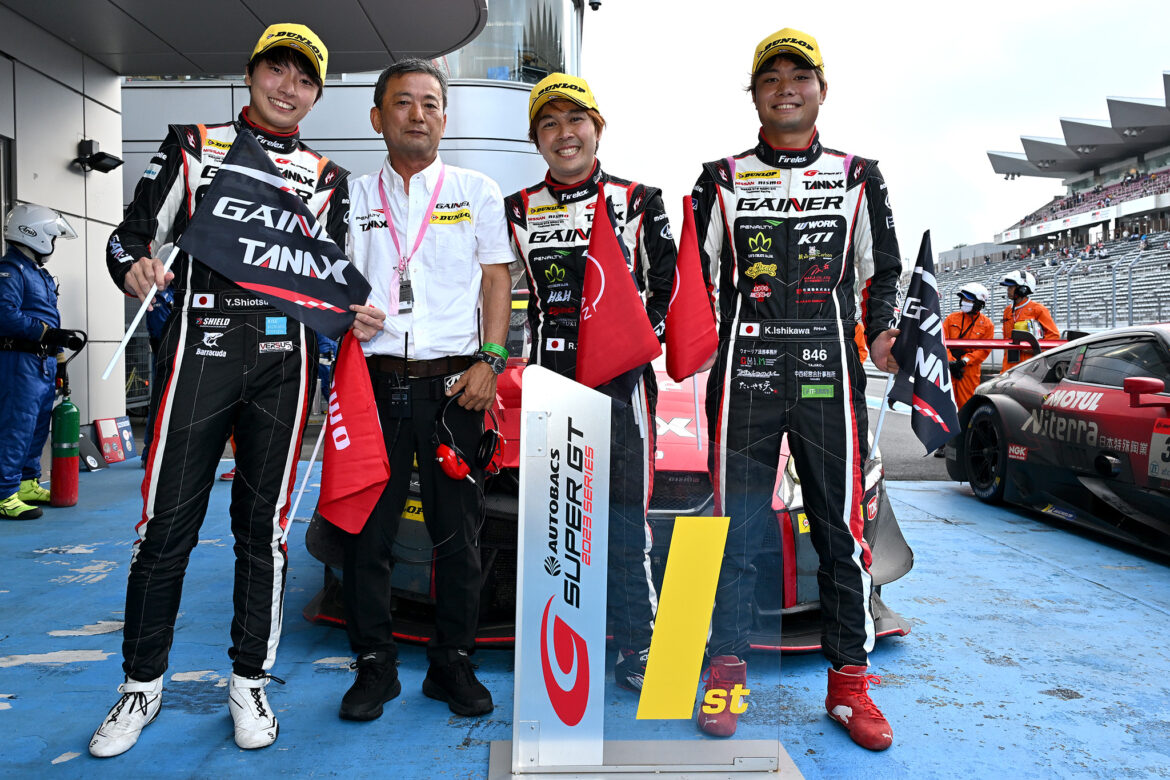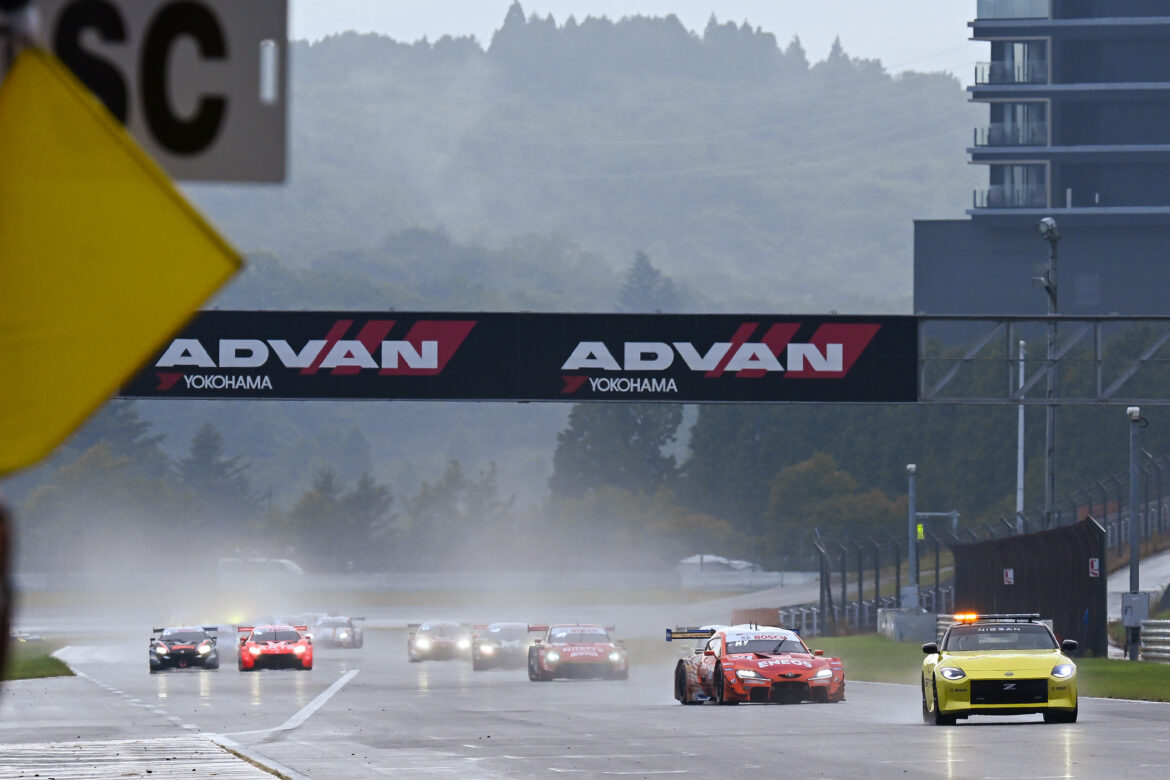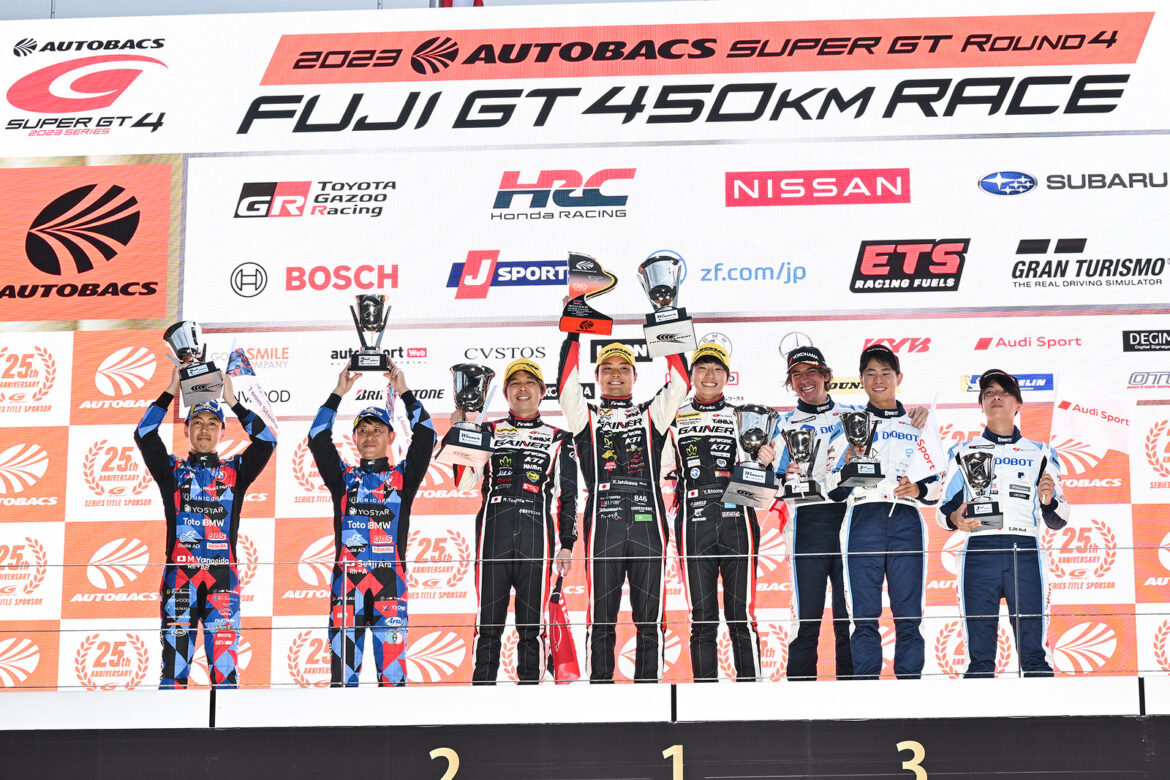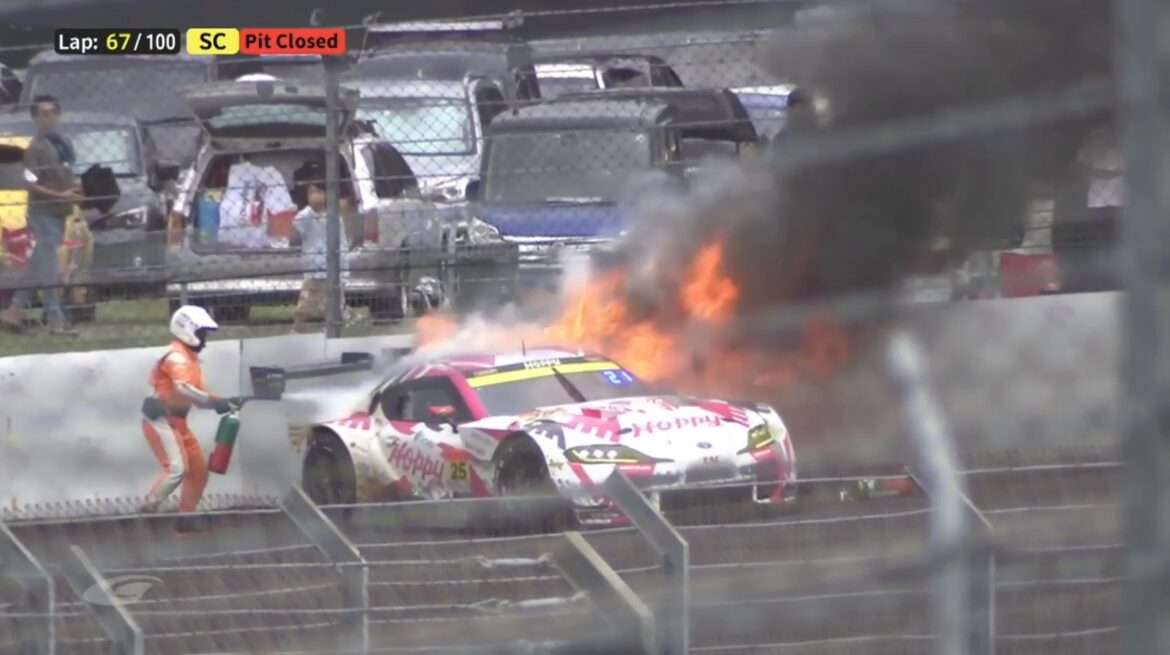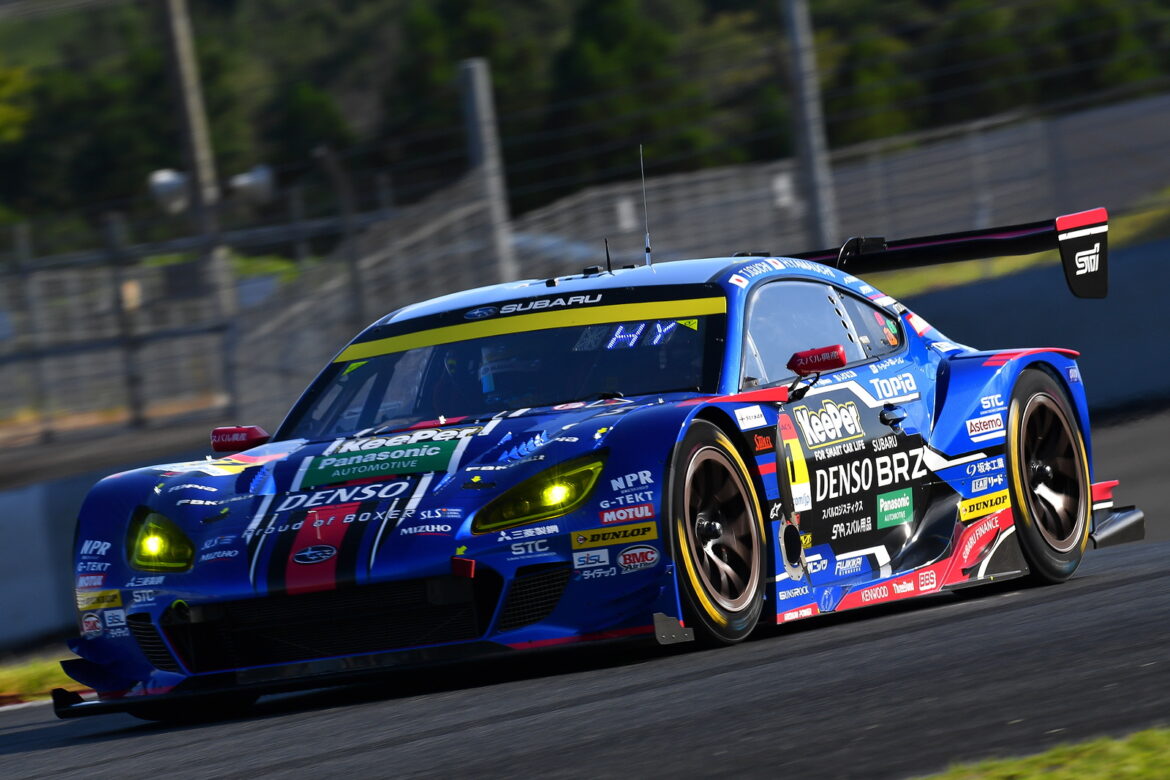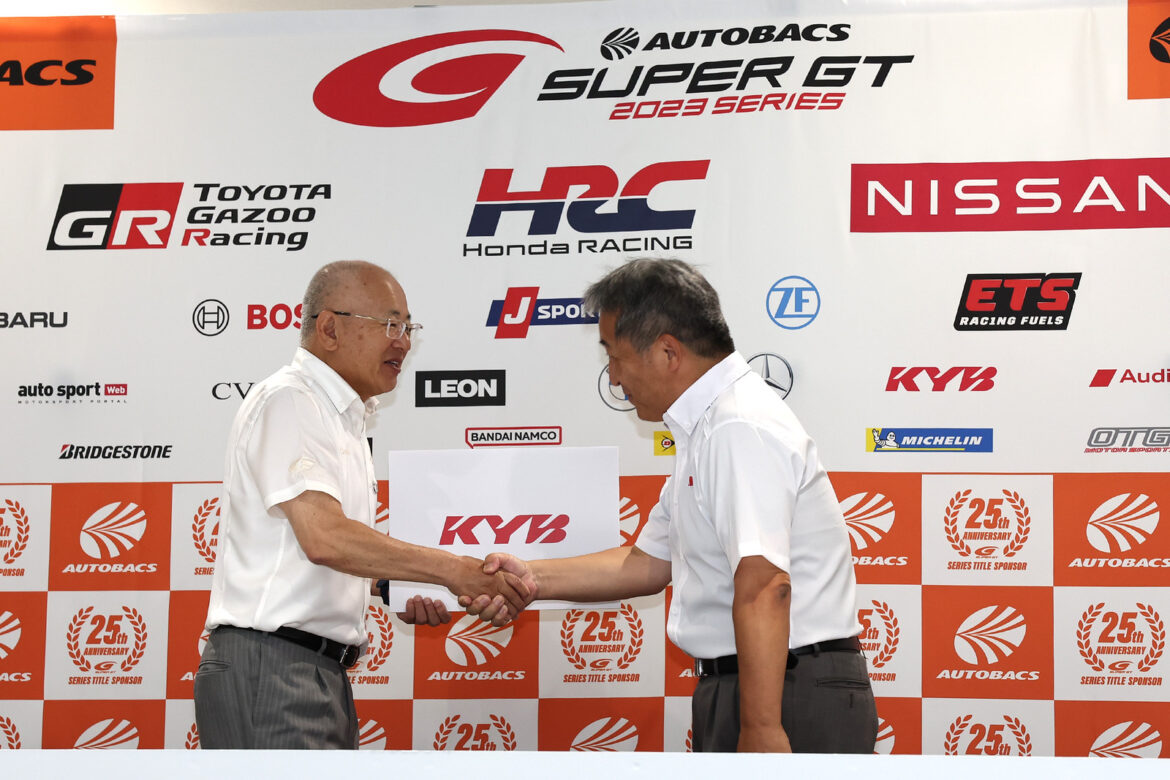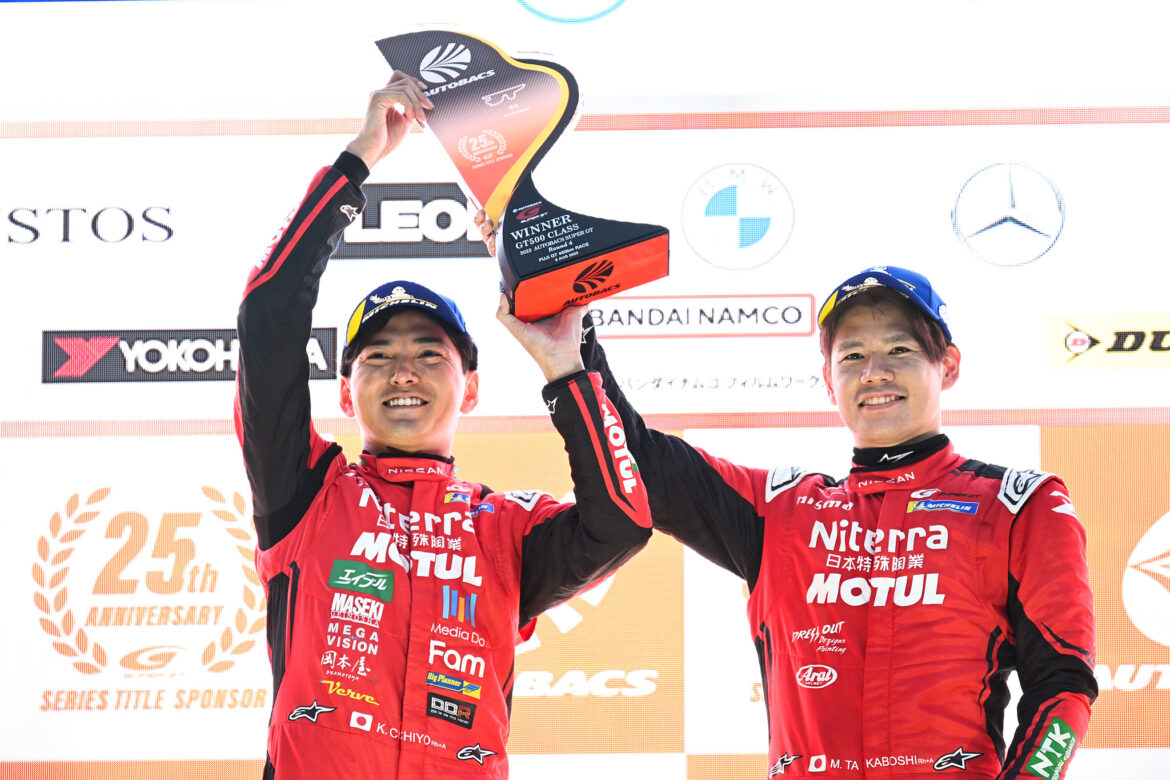After a two-month long break, SUPER GT was finally back in action again at Fuji Speedway last weekend. Ahead of the start of the fourth round of the 2023 season, GTA chairman Masaaki Bandoh not only talked about the “Suzuka penalty saga”, but also revealed with KYB a new series sponsor, shared his thoughts on reviving the Suzuka 1000 km and confirmed that overseas rounds are on the table for 2025. Here’s our translation and summary of the GTA press conference.
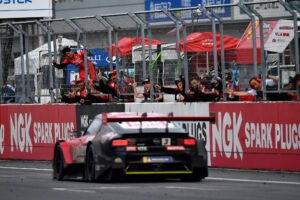 SUPER GT’s first race after its early summer break turned out to be a thrilling affair. Following a start behind the Safety Car on a wet but rapidly drying track, the race got interrupted by a red flag due to a fire incident of GT300’s Hoppy Schatz GR Supra GT. During the interruption, a sudden downpour turned the race upside down, which despite the red flag situation was able to end after completing the full distance of 450 km (100 laps). In the end, a perfect strategic call during the intermission as well as perfect usage of their advantageous Michelin wet tyres, the Niterra Motul Z of Katsumasa Chiyo / Mitsunori Takaboshi won for the first time this season in GT500. Following two post-race penalties for changing tyres while refueling, Nakajima Racing’s Modulo NSX-GT (Takuya Izawa / Kakunoshin Ohta) finished second for the first time since the penultimate round of the 2020 season. It was Ohta’s first GT500 podium. Dropping down from second following their 40-second post-race time penalty, the #16 ARTA Mugen NSX-GT (Nirei Fukuzumi / Hiroki Otsu) finished on the final spot of the podium. Originally coming home in third, the Stanley NSX-GT (Naoki Yamamoto / Tadasuke Makino) dropped down to P6 after being hit with the before mentioned pit work violation penalty.
SUPER GT’s first race after its early summer break turned out to be a thrilling affair. Following a start behind the Safety Car on a wet but rapidly drying track, the race got interrupted by a red flag due to a fire incident of GT300’s Hoppy Schatz GR Supra GT. During the interruption, a sudden downpour turned the race upside down, which despite the red flag situation was able to end after completing the full distance of 450 km (100 laps). In the end, a perfect strategic call during the intermission as well as perfect usage of their advantageous Michelin wet tyres, the Niterra Motul Z of Katsumasa Chiyo / Mitsunori Takaboshi won for the first time this season in GT500. Following two post-race penalties for changing tyres while refueling, Nakajima Racing’s Modulo NSX-GT (Takuya Izawa / Kakunoshin Ohta) finished second for the first time since the penultimate round of the 2020 season. It was Ohta’s first GT500 podium. Dropping down from second following their 40-second post-race time penalty, the #16 ARTA Mugen NSX-GT (Nirei Fukuzumi / Hiroki Otsu) finished on the final spot of the podium. Originally coming home in third, the Stanley NSX-GT (Naoki Yamamoto / Tadasuke Makino) dropped down to P6 after being hit with the before mentioned pit work violation penalty.
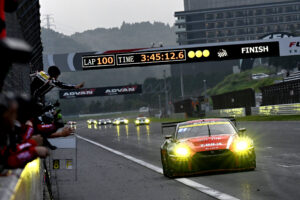 In GT300, the Gainer Tanax GT-R (Ryuichiro Tomita / Keishi Ishikawa / Yusuke Shiotsu) dashed to victory after an incredible last monster stint by GT3 expert Tomita, who switched from wet to dry tyres in just the right time and managed to overcome a 50-second deficit in just a few laps to take the #11 car’s first victory since Round 3 in 2020. Following their victory last time at Suzuka, Seiji Ara and Masataka Yanagida in the Studie BMW M4 came home second after starting from P16 on the grid. For the first time since leaving GT500 and joining GT300, the Dobot Audi R8 LMS (Yoshiaki Katayama / Roberto Mehri / Seiya Jin) of Team LeMans finished third. The Subaru BRZ R&D Sport (Takuto Iguchi / Hideki Yamauchi) took the gamble to stay out on wet tyres, to salvage a difficult race. But the drying track meant that Iguchi lost up to eight seconds per lap. In the end, the blue boxer got turned in the final corner of the final lap by Hiroki Yoshimoto (Syntium LMcorsa GR Supra GT), resulting in a 40-second post-race time penalty for the Supra, dropping it down to P10. The BRZ ended up finishing sixth. Polesitter and long-time leader of the race, the Goodsmile Hatsune Miku AMG (Nobuteru Taniguchi / Tatsuya Kataoka), was set to fight for the win, but a spin shortly after switching from wet to dry tyres by Taniguchi with just nine laps to go destroyed all their hopes. The popular team saw the checkered flag on P12, but found solace by winning the fan voted J SPORTS Best Performance Award.
In GT300, the Gainer Tanax GT-R (Ryuichiro Tomita / Keishi Ishikawa / Yusuke Shiotsu) dashed to victory after an incredible last monster stint by GT3 expert Tomita, who switched from wet to dry tyres in just the right time and managed to overcome a 50-second deficit in just a few laps to take the #11 car’s first victory since Round 3 in 2020. Following their victory last time at Suzuka, Seiji Ara and Masataka Yanagida in the Studie BMW M4 came home second after starting from P16 on the grid. For the first time since leaving GT500 and joining GT300, the Dobot Audi R8 LMS (Yoshiaki Katayama / Roberto Mehri / Seiya Jin) of Team LeMans finished third. The Subaru BRZ R&D Sport (Takuto Iguchi / Hideki Yamauchi) took the gamble to stay out on wet tyres, to salvage a difficult race. But the drying track meant that Iguchi lost up to eight seconds per lap. In the end, the blue boxer got turned in the final corner of the final lap by Hiroki Yoshimoto (Syntium LMcorsa GR Supra GT), resulting in a 40-second post-race time penalty for the Supra, dropping it down to P10. The BRZ ended up finishing sixth. Polesitter and long-time leader of the race, the Goodsmile Hatsune Miku AMG (Nobuteru Taniguchi / Tatsuya Kataoka), was set to fight for the win, but a spin shortly after switching from wet to dry tyres by Taniguchi with just nine laps to go destroyed all their hopes. The popular team saw the checkered flag on P12, but found solace by winning the fan voted J SPORTS Best Performance Award.
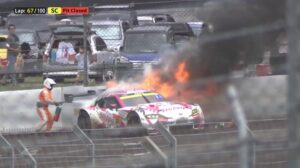 The cause for the red flag was a fire incident by the Hoppy Schatz GR Supra GT (Togo Suganami / Seita Nonaka). As Takeshi Tsuchiya explained, for some reason a part of the exhaust broke off the car. The generated heat burned the car. Because a fuel line got hit, the car went up in massive flames, which the marshals first had issues to extinguish. In a desperate attempt, Seita Nonaka, who’s thankfully uninjured, tried to keep the car away from the tyre barrier, as the car was slowly rolling downhill in the 100R corner. Unfortunately, Tsuchiya confirmed that the car is beyond repair and won’t return anymore this year. It’s another setback for the small privateers, who faced many hurdles such as accidents in the most recent years and received help from other teams to get back on the track. Tsuchiya explained that despite Sunday’s tragedy, they don’t want to give up, even if they’re only moving forward in inches. They now have to secure the funds to build a new and upgraded version of the “Hopiko”. Unlike the other Toyota GR Supra GT’s in GT300, which were alle built by apr, Tsuchiya’s car is handmade and thus slightly different. He doesn’t know how long it’ll take before they’ll return to SUPER GT. But they’re eager to overcome this hurdle and hope for the fans to patiently await their return.
The cause for the red flag was a fire incident by the Hoppy Schatz GR Supra GT (Togo Suganami / Seita Nonaka). As Takeshi Tsuchiya explained, for some reason a part of the exhaust broke off the car. The generated heat burned the car. Because a fuel line got hit, the car went up in massive flames, which the marshals first had issues to extinguish. In a desperate attempt, Seita Nonaka, who’s thankfully uninjured, tried to keep the car away from the tyre barrier, as the car was slowly rolling downhill in the 100R corner. Unfortunately, Tsuchiya confirmed that the car is beyond repair and won’t return anymore this year. It’s another setback for the small privateers, who faced many hurdles such as accidents in the most recent years and received help from other teams to get back on the track. Tsuchiya explained that despite Sunday’s tragedy, they don’t want to give up, even if they’re only moving forward in inches. They now have to secure the funds to build a new and upgraded version of the “Hopiko”. Unlike the other Toyota GR Supra GT’s in GT300, which were alle built by apr, Tsuchiya’s car is handmade and thus slightly different. He doesn’t know how long it’ll take before they’ll return to SUPER GT. But they’re eager to overcome this hurdle and hope for the fans to patiently await their return.
Just a few laps earlier, the by Tsuchiya Engineering prepared HACHI-ICHI GR Supra GT of Max Racing also went up in flames because of what appears to be the same issue. Unlike the “Hopiko”, the flames didn’t hit the fuel line of Max Racing’s car, which resulted in a much smaller fire. Since the damage seems less severe, team director Tetsuya Tanaka is hopeful that they can complete the repair work in time for the upcoming Suzuka round on August 27.
Overseas races in Malaysia and China on the table for 2025, but high logistics costs remain a major issue
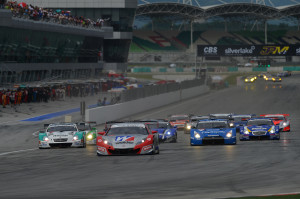 At Sunday morning’s press conference, GTA chairman Masaaki Bandoh reveled that the GTA is hopeful to add at least one overseas round back on the calendar starting with the 2025 season. The last race outside of Japan was held 2019 in Buriram, Thailand. There have been plans to return to Sepang, Malaysia for the first time since 2013 in 2020 for the series’ first ever night race, but the plans to get put on hold because of the COVID-19 pandemic. As Bandoh explained, the talks with the organizers in Malaysia are progressing, but the high logistic costs, which have doubled compared to before the pandemic, as well as hosting fees remain a major issue. “So, we are still in the exploratory stage”, Bandoh said.
At Sunday morning’s press conference, GTA chairman Masaaki Bandoh reveled that the GTA is hopeful to add at least one overseas round back on the calendar starting with the 2025 season. The last race outside of Japan was held 2019 in Buriram, Thailand. There have been plans to return to Sepang, Malaysia for the first time since 2013 in 2020 for the series’ first ever night race, but the plans to get put on hold because of the COVID-19 pandemic. As Bandoh explained, the talks with the organizers in Malaysia are progressing, but the high logistic costs, which have doubled compared to before the pandemic, as well as hosting fees remain a major issue. “So, we are still in the exploratory stage”, Bandoh said.
However, the GTA has made plans to hold a winter test in Sepang in January of 2024, just as it was the case before the pandemic, but without any GT300 cars and just one GT500 vehicle per manufacturer, so that the other teams can test in Japan to keep the costs down. If this can be realized, Bandoh is exploring the possibility of whether they can hold an official pre-season test in early 2025, followed by starting the season a month later in February. In 2025, the Malaysia government is planning to hold a “Visit Malaysia” campaign and SUPER GT could act as a catalyst for Japanese tourists visiting the country.
Additionally, there has been renewed interest from the officials at Shanghai International Circuit in China. But as Bandoh explained, they’re still far from a mutual agreement and haven’t found any specific points to work on. Editor’s note: In the past there have been multiple attempts to hold a race in China. Even a joint test with DTM was on the table, but those talks never went past the initial talks.
Following the announcement of the provisional 2024 calendar, Masaaki Bandoh also revealed that the official pre-season tests for the 2024 will be held on March 16-17 at Okayama and on March 23-24 at Fuji Speedway, as Formula E is racing in Tokyo for the very first time on March 30, followed by the Japanese Formula One Grand Prix a week later.
Is a revival of the Suzuka 1000 km possible?
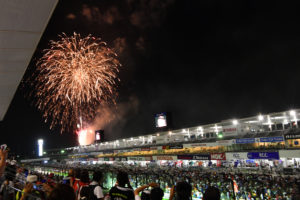 Next up on the SUPER GT calendar is the Suzuka summer round, which traditionally used to be the Suzuka 1000 km event until 2017, before the race morphed into a 10-hour race for GT3 cars as part of the Intercontinental GT Challenge. Ever since the pandemic, said event hasn’t returned, which is why a local journalist asked if there are plans for SUPER GT to revive the once known as “Pokka International Pokka 1000 km” race. Masaaki Bandoh explained that if they can get proof that the fans would be happy with the return of the race, they would bring it back immediately. However, as explained, the race turned into a 10-hour event, which makes a revival difficult and they would have to hold more discussion about it. Furthermore, in order to hold a 1000 km race, they have to consider the issue of increased carbon dioxide emissions and they would have to carefully consider if whether a 1000 km endurance format would still attract many visitors to come to the circuit. In case of Suzuka, there also may be desire to have fireworks at the end of the race, so there is room for consideration of making it a time-based race similar to the 10-hour event to accommodate for this. Either way: The key is to create an event that will attract as many fans as possible, Bandoh explained.
Next up on the SUPER GT calendar is the Suzuka summer round, which traditionally used to be the Suzuka 1000 km event until 2017, before the race morphed into a 10-hour race for GT3 cars as part of the Intercontinental GT Challenge. Ever since the pandemic, said event hasn’t returned, which is why a local journalist asked if there are plans for SUPER GT to revive the once known as “Pokka International Pokka 1000 km” race. Masaaki Bandoh explained that if they can get proof that the fans would be happy with the return of the race, they would bring it back immediately. However, as explained, the race turned into a 10-hour event, which makes a revival difficult and they would have to hold more discussion about it. Furthermore, in order to hold a 1000 km race, they have to consider the issue of increased carbon dioxide emissions and they would have to carefully consider if whether a 1000 km endurance format would still attract many visitors to come to the circuit. In case of Suzuka, there also may be desire to have fireworks at the end of the race, so there is room for consideration of making it a time-based race similar to the 10-hour event to accommodate for this. Either way: The key is to create an event that will attract as many fans as possible, Bandoh explained.
300 mile or timed-based races in 2024?
Speaking of the prospect of a time-based race at Suzuka, Masaaki Bandoh also revealed that the GTA is continuously exploring new variations to make the races even more interesting. For example, he was thinking what would happen if they would slightly increase the distance and for example add a 300-mile (480 km) or a 3-hour time-based race, which should have an impact on the fuel usage. For that matter, the GTA is exploring various ideas for the 2024 season. And while no decision has been made yet, the number of available tyres will be reduced again in accordance to SUPER GT’s roadmap to reduce the carbon dioxide emission by 50% until 2030.
About the Suzuka penalty saga: The GTA’s role isn’t to judge, but to clarify and create regulations
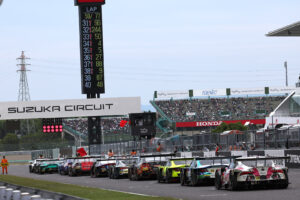 Masaaki Bandoh expressed his relive that all drivers involved in the violent accident that occurred at Suzuka in early June have recovered. Racing, as Bandoh said, must always be safe and there are various methodologies to create such safety. The GTA chairman revealed that Tsugio Matsuda’s impact at Suzuka had 58G. At least year’s Fuji Golden Week incident, Mitsunori Takaboshi’s car turned out to be much greater. But while the vehicle split into multiple parts, the most important part, the monocoque and driver cell, remained intact. Bandoh said the GT500’s monocoque is currently the strongest in the world of “touring cars”, which is why they want to use it as main foundation for future developments (editor’s note: aka the next-gen GT500 regulations) while continue to promote environmental friendliness.
Masaaki Bandoh expressed his relive that all drivers involved in the violent accident that occurred at Suzuka in early June have recovered. Racing, as Bandoh said, must always be safe and there are various methodologies to create such safety. The GTA chairman revealed that Tsugio Matsuda’s impact at Suzuka had 58G. At least year’s Fuji Golden Week incident, Mitsunori Takaboshi’s car turned out to be much greater. But while the vehicle split into multiple parts, the most important part, the monocoque and driver cell, remained intact. Bandoh said the GT500’s monocoque is currently the strongest in the world of “touring cars”, which is why they want to use it as main foundation for future developments (editor’s note: aka the next-gen GT500 regulations) while continue to promote environmental friendliness.
About the penalty saga that occurred last time, where the declaration of the official results took over a week (see my article about it here), Bandoh explained that the judging committee used 2022’s Fuji Golden Week round as a precedent. Said race was red flagged following Takaboshi’s accident and cancelled with less than 75% of the distance completed, awarding only half championship points. At that time, no penalties were given, even if there hasn’t been any driver changes up to this point. Last year, the committee discussed whether the sporting regulations needed to be clarified and written in the bylaws, and the result of the discussion was to leave the matter to the review committee. Using this as a precedent, the judging committee made a “ruling” for this year’s Suzuka round, which ended with the red flag and 75% of the race distance completed following the three-car horror accident.
SUPER GT’s sporting regulations don’t allow a decision to be protested. However, a “ruling” can be protested. So, when the judging committee made the ruling for the results based on last year’s precedent, it then got protested by all but two GT500 teams, which ended up in a new ruling and a change in results. The whole situation has been quite complicated and I recommend reading my before mentioned article about the whole “penalty saga” to fully grasp it.
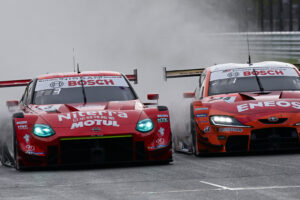 As Masaaki Bandoh explained, it’s the job of the judging committee to make such rulings. The GTA, however, is not involved in making rulings. Instead, the GTA’s role is to create and clarify the regulations, which are then used by the judging committee in their rulings. That’s why the GTA adjusted the regulations following the Suzuka round and clarified that if a race ends early with 75% of the distance completed, all teams that haven’t completed their pit stop obligations (two refueling stops in case of the 450km races), they will receive a 60-second time penalty – the equivalent of one pit stop. However, if the race ends early with less than 75% completed, no penalties will be given, even if the pit stop obligations haven’t been fulfilled yet.
As Masaaki Bandoh explained, it’s the job of the judging committee to make such rulings. The GTA, however, is not involved in making rulings. Instead, the GTA’s role is to create and clarify the regulations, which are then used by the judging committee in their rulings. That’s why the GTA adjusted the regulations following the Suzuka round and clarified that if a race ends early with 75% of the distance completed, all teams that haven’t completed their pit stop obligations (two refueling stops in case of the 450km races), they will receive a 60-second time penalty – the equivalent of one pit stop. However, if the race ends early with less than 75% completed, no penalties will be given, even if the pit stop obligations haven’t been fulfilled yet.
Masaaki Bandoh: “If there is a problem with the regulations that prevent a smooth operation of the race, the GTA will change it. We don’t want to fail to deliver the results to the fans who have come to watch the races.”
The GTA presents KYB as a new series sponsor
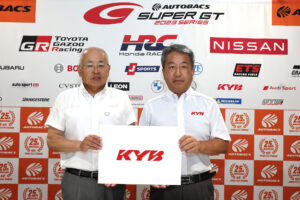 Ahead of the press conference, KYB Corporation has been presented as a new series sponsor. KYB Corporation is the leading hydraulics company in Japan. Next to producing automotive parts such as hydraulic pumps and shock absorbers, they’re also producing the active suspension for Japan’s bullet train, the Shinkansen. Kazunori Masumoto, general manager of KYB’s motorsports department. „Our objective is to nurture human resources through the provisioning of our technology to the series which, we believe, will contribute to further development of the automobile industry.“
Ahead of the press conference, KYB Corporation has been presented as a new series sponsor. KYB Corporation is the leading hydraulics company in Japan. Next to producing automotive parts such as hydraulic pumps and shock absorbers, they’re also producing the active suspension for Japan’s bullet train, the Shinkansen. Kazunori Masumoto, general manager of KYB’s motorsports department. „Our objective is to nurture human resources through the provisioning of our technology to the series which, we believe, will contribute to further development of the automobile industry.“
Masaaki Bandoh expressed his gratitude and welcomed KYB on board of SUPER GT: “(As a fan of cars) I’ve been enjoying, directly and indirectly, a wide variety of products made by KYB that I know from my childhood. I’ve used their products in racing as well as on my car that I drove on the streets. It is so grateful that such company has offered to support to build together the motorsports of Japan by promoting and developing the motorsports through SUPER GT. We can give back for the contribution the company has been giving through the hardware they produce for the GT300 and 500 classes by providing opportunities to obtain know-how which, we hope, will lead to their recruitment and also to the growth of the industry, which will certainly be a shared path for both of us.“
Copyright photos: GT Association (GTA)

